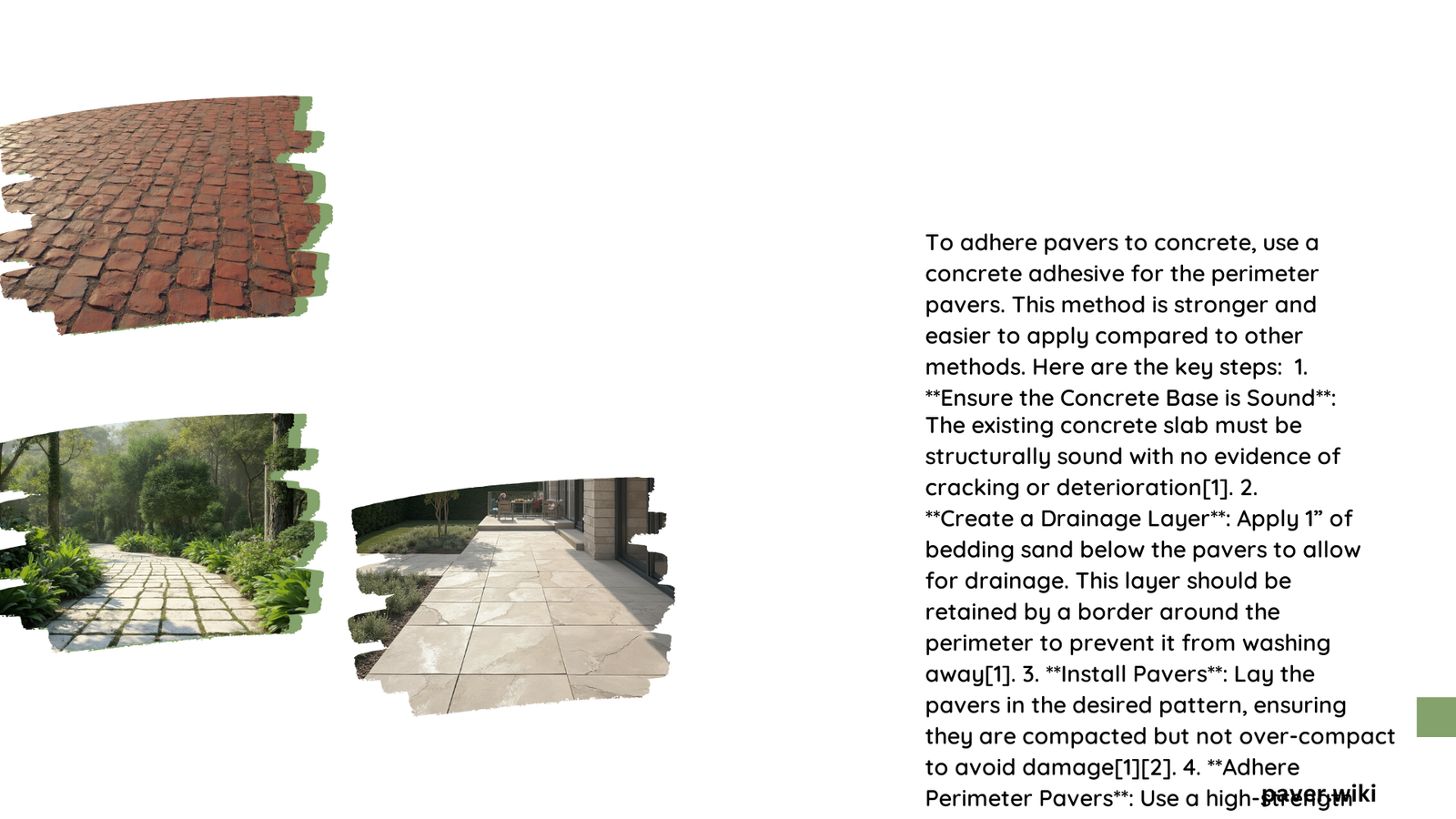Adhering pavers to concrete is a popular method for enhancing outdoor spaces. This process involves attaching paving stones to an existing concrete surface using specialized adhesives. The technique provides a durable, low-maintenance solution that can transform plain concrete patios, walkways, or driveways into attractive, customized hardscapes. By following proper installation methods and using appropriate materials, homeowners and contractors can achieve long-lasting results that resist shifting and settling.
What Are the Key Steps to Adhere Pavers to Concrete?
The process of adhering pavers to concrete involves several crucial steps:
- Surface Preparation
- Adhesive Selection and Application
- Paver Placement
- Curing and Finishing
Let’s explore each of these steps in detail.
1. Surface Preparation
Before adhering pavers to concrete, proper surface preparation is essential:
- Clean the concrete surface thoroughly using a pressure washer or stiff brush
- Remove any debris, oil, or old adhesives
- Fill cracks or uneven areas with a suitable patching compound
- Allow the surface to dry completely
2. Adhesive Selection and Application
Choosing the right adhesive is crucial for a successful installation:
- Use a polymer-modified thinset mortar or specialized paver adhesive
- Apply the adhesive using a notched trowel
- Ensure even coverage on both the concrete surface and the back of the pavers
3. Paver Placement
Careful placement of pavers is key to achieving a professional look:
- Start with border pavers, which should be at least 3/4 inch thicker than field pavers
- Maintain consistent joint spacing (typically 1/8 to 1/4 inch)
- Use a level and straightedge to ensure proper alignment
- Tap pavers gently with a rubber mallet to set them in place
4. Curing and Finishing
Allow sufficient time for the adhesive to cure:
- Follow manufacturer’s instructions for curing times
- Avoid foot traffic during the curing period
- Once cured, fill joints with polymeric sand if desired
What Are the Best Adhesives for Adhering Pavers to Concrete?

Selecting the right adhesive is crucial for a successful paver installation. Here are some top choices:
- Polymer-Modified Thinset Mortar
- Specialized Paver Adhesive
- Epoxy-Based Adhesives
| Adhesive Type | Pros | Cons |
|---|---|---|
| Polymer-Modified Thinset Mortar | Strong bond, flexible, weather-resistant | Longer curing time |
| Specialized Paver Adhesive | Quick-setting, easy to use | May be more expensive |
| Epoxy-Based Adhesives | Extremely strong bond, chemical-resistant | Difficult to work with, less forgiving |
How Does Adhering Pavers to Concrete Benefit Homeowners?
Adhering pavers to concrete offers several advantages:
- Increased Durability: Properly adhered pavers can last 20-30 years with minimal maintenance.
- Reduced Maintenance: Less need for sand replenishment and re-leveling.
- Improved Stability: Significant reduction in shifting and settling compared to non-adhered pavers.
- Enhanced Aesthetics: Ability to customize and upgrade existing concrete surfaces.
What Are the Specific Requirements for Adhering Pavers to Concrete?
To ensure a successful installation, consider the following specifications:
Paver Thickness
- Border pavers: At least 3/4 inch thicker than field pavers
- Field pavers: Typically 1 to 2 inches thick
Joint Spacing
- For sand-set pavers: 1/8 to 1/4 inch
- For directly adhered pavers: Minimal spacing, but allow for some movement
Essential Tools
- Notched trowel
- Level and straightedge
- Rubber mallet
- Safety goggles and gloves
Cost Considerations
- Pavers: $3 to $15 per square foot
- Adhesive: $0.50 to $2 per square foot
- Labor: $5 to $15 per square foot (varies by location and complexity)
How Can Homeowners Ensure Long-Lasting Results When Adhering Pavers to Concrete?
To maximize the lifespan and appearance of adhered pavers:
- Choose high-quality materials suitable for your climate
- Follow manufacturer’s instructions for adhesive application and curing
- Maintain proper drainage to prevent water accumulation
- Seal the pavers and joints to protect against stains and weathering
- Perform regular cleaning and maintenance
By following these guidelines and best practices, homeowners can successfully adhere pavers to concrete, creating beautiful and durable outdoor spaces that will last for years to come.
References:
1. [https://www.familyhandyman.com/project/how-to-cover-a-concrete-patio-with-pavers/]
2. [https://extension.oregonstate.edu/sites/default/files/documents/1/howtoinstallpavers.pdf]
3. [https://westerninterlock.com/how-to-prep-lay-a-base-for-pavers/]
